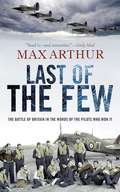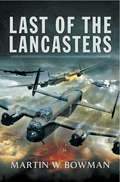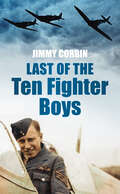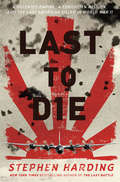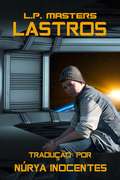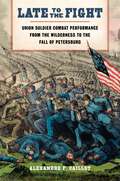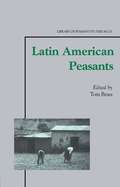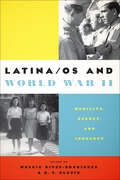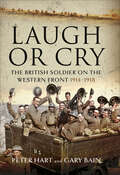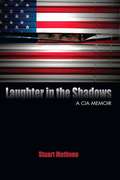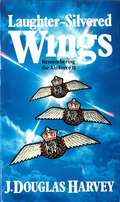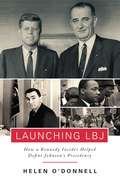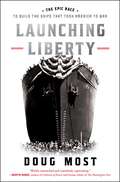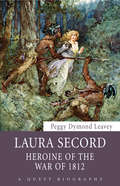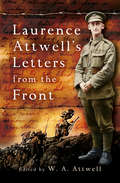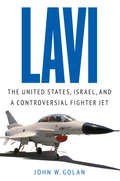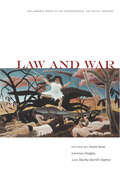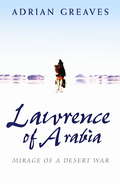- Table View
- List View
Last of the Few: The Battle of Britain in the Words of the Pilots Who Won It
by Max ArthurAfter the fall of France in May 1940, the British Expeditionary Force was miraculously evacuated from Dunkirk. Britain now stood alone to face Hitler's inevitable invasion attempt. For the German army to land across the channel, Hitler needed mastery of the skies-the Royal Air Force would have to be broken. So every day throughout the summer, German bombers pounded the RAF air bases in the southern counties. Greatly outnumbered by the Luftwaffe, the pilots of RAF Fighter Command scrambled as many as five times a day, and civilians watched skies crisscrossed with the contrails from the constant dogfights between Spitfires and Me-109s. Britain's very freedom depended on the outcome of that summer's battle: Its air defenses were badly battered and nearly broken, but against all odds, "The Few," as they came to be known, bought Britain's freedom-many with their lives. More than a fifth of the British and Allied pilots died during the Battle of Britain. These are the personal accounts of the pilots who fought and survived that battle. Their stories are as riveting, as vivid, and as poignant as they were seventy years ago. We will not see their like again.
Last of the Lancasters
by Martin W. Bowman'The Lancasters looked like enormous deadly black birds going off into the night; somehow they looked different when they came back. The planes carried from this field 117,000 pounds of high explosives and the crews flew all night to drop the load as ordered. Now the trains would not run between France and Italy for a while, not on those bombed tracks anyhow. Here are the men who did it, with mussed hair and weary faces, dirty sweaters under their flying suits, sleep-bright eyes, making humble comradely little jokes and eating their saved-up chocolate bars' Martha GellhornThis riveting and highly intriguing collection of pilot and civilian reminiscences works to commemorate the spirit of the almighty Lancaster bomber. Each chapter is dedicated to a unique individual or group of individuals who took part in its history in some capacity. Be they pilot, civilian, or journalist, each played their own part and their accounts offer a host of fascinating insights. Episodes featured include the battle for Munich and the Nuremburg and Berlin Raids. Stories of PoWs downed in their Lancasters and captured in enemy territory also feature, communicating a real sense of peril experienced behind enemy lines. Two sections of fascinating black and white photographs supplement and complete this trawl through the history of the Lancaster bomber and the men and women who witnessed its glory days.
Last of the Pirates: The Search for Bob Denard
by Samantha WeinbergThis riveting book gives an account of an intrepid young woman's eccentric quest, as Samantha Weinberg pursues one of the last of a dying breed: an elusive French mercenary who plied his trade, ruthlessly, throughout the African continent. The Comoros are small specks in the Indian Ocean, four volcanic islands known for their beauty and for ylang-ylang, an exotic flower whose extract is widely used in French perfumes. For many years they were also the home of Bob Denard, who arrived by way of Katanga, the Congo, Yemen, Angola, Biafra, Gabon, and Benin. Once in the Comoros, he overthrew two presidents in three years. In 1989 he, too, was overthrown, and then he disappeared. Last of the Pirates is a thrilling story of beauty, intrigue, cruelty, and murder: a book about an exotic place few of us have ever imagined, and about a murderous, machista culture that aimed to transform it.
Last of the Ten Fighter Boys
by Jimmy CorbinIn 1940, against the backdrop of the Battle of Britain, 66 Squadron’s commanding officer, Squadron Leader Athol Forbes, asked ten of his pilots to record their experiences of flying one of the greatest aerial battles ever waged.The Ten Fighter Boys, published in 1942, comprised the first-hand accounts of pilot officers and sergeant pilots from all walks of life among them was Sergeant Jimmy Corbin, who wrote the third chapter. He was 23 – old by pilot standards – and, like the rest of the squadron, based at Biggin Hill, Kent. Now, sixty years later, Flight Lieutenant Jimmy Corbin, Spitfire pilot, tells his extraordinary wartime story. He describes how an ordinary working-class boy from Maidstone was propelled into the thick of action in the skies over Kent during the summer and autumn of 1940. As the sole survivor of the original ‘Ten Fighter Boys’, Jimmy’s story is all the more poignant now that the men who fought the Battle of Britain pass from living memory.
Last to Die: A Defeated Empire, a Forgotten Mission, and the Last American Killed in World War II
by Stephen HardingOn August 18, 1945, US Army sergeant Anthony J. Marchione bled to death in the clear, bright sky above Tokyo. Marchione, a gunner in the US Air Forces, died like so many before him in World War II--quietly, cradled in the arms of a buddy. Though tragic, Marchione’s death would have been no more notable than any other had he not had the dubious distinction of being the last American killed in World War II combat. Based on official American and Japanese histories, personal memoirs, and the author’s exclusive interviews with many of the story’s key participants, Last to Die is a rousing tale of air combat, bravery, cowardice, hubris, and determination, all set during the turbulent and confusing final days of World War II.
Lastres
by L. P. MastersLa nave de guerra espacial en la que sirve Kaden Lowery, de 14 años, está siendo atacada por un enemigo invisible: la gravedad. Kaden deberá enfrentarse a su pasado y a quién es para salvarse a sí mismo y a la tripulación.
Lastros
by L. P. Masters Núrya InocentesO maior inimigo que eu enfrento é a gravidade. A nave de guerra de espaço profundo onde Kaden Lowery, com catorze anos, serve está sob o ataque de um inimigo invisível: a gravidade. Kaden deve conciliar-se com o seu passado e com quem é de maneira a salvar-se a ele próprio e a tripulação.
Latac a la raó
by Al Gore«Mai no ha estat tan important que encarem la realitat dels nostres reptes a llarg termini, des de la crisi del clima fins a la guerra de lIraq, passant per moltes altres qüestions. La raó és atacada per forces que fan servir tècniques sofisticades, com la propaganda, la psicologia i els medis de comunicació electrònics. Tot i que els reptes als quals ens enfrontem són grans, tinc més confiança que mai en el fet que la democràcia triomfarà i que estarem a lalçada del desafiament. Espero que els que llegeixin aquest llibre decideixin formar part dun nou moviment que ho faci possible.» Al Gore
Late to the Fight: Union Soldier Combat Performance from the Wilderness to the Fall of Petersburg (Conflicting Worlds: New Dimensions of the American Civil War)
by Alexandre F. CaillotIn Late to the Fight, Alexandre F. Caillot explores the combat performance of the Union soldiers who filled newly raised regiments that fought through the Civil War’s final year. Historians have typically regarded these late enlistees as substandard to those who signed on at the war’s start. Using the experiences of the 17th Vermont and 31st Maine Volunteer Infantry Regiments to assess the record of late-arriving soldiers under fire, Caillot shows that these forgotten boys in blue left behind a record of valor and sacrifice essential to achieving the destruction of the Confederacy.
Latin American Peasants
by Tom BrassThe essays in this collection examine agrarian transformation in Latin America and the role in this of peasants, with particular reference to Bolivia, Peru, Chile, Brazil and Central America. Among the issues covered are the impact of globalization and neo-liberal economic policies.
Latina/os and World War II: Mobility, Agency, and Ideology
by Maggie Rivas-RodríguezThis eye-opening anthology documents the effects of WWII on Latina/o personal and political beliefs across a broad spectrum of ethnicities and races.The first book-length study of Latina/o experiences in World War II over a wide spectrum of identities and ancestries—from Cuban American, Spanish American, and Mexican American segments to the under-studied Afro-Latino experience—Latina/os and World War II probes the controversial aspects of Latina/o soldiering and citizenship in the war, the repercussions of which defined the West during the twentieth century. The editors also offer a revised, more accurate tabulation of the number of Latina/os who served in the war.Spanning imaginative productions, such as vaudeville and the masculinity of the soldado razo theatrical performances; military segregation and the postwar lives of veterans; Tejanas on the homefront; journalism and youth activism; and other underreported aspects of the wartime experience, the essays collected in this volume showcase rarely seen recollections. Whether living in Florida in a transformed community or deployed far from home (including Mexican Americans who were forced to endure the Bataan Death March), the men and women depicted in this collection yield a multidisciplinary, metacritical inquiry. The result is a study that challenges celebratory accounts and deepens the level of scholarly inquiry into the realm of ideological mobility for a unique cultural crossroads. Taking this complex history beyond the realm of war narratives, Latina/os and World War II situates these chapters within the broader themes of identity and social change that continue to reverberate in postcolonial lives.
Laugh or Cry: The British Soldier on the Western Front, 1914–1918
by Peter Hart Gary BainAwakened by great shouted oaths below. Peeped over the side of the manger and saw a Belgian lass milking and addressing a cow with a comprehensive luridness that left no doubt in my mind that British soldiers had been billeted here before.' - Private Norman Ellison, 1/6th King’s Liverpool Regiment Humor helped the British soldier survive the terrible experiences they faced in the trenches of the Western Front during the Great War. Human beings are complicated, and there is no set pattern as to how they react to the outrageous stresses of war. But humor, often dark and representative of the horrors around them could and often did help. They may have been up to their knees in mud and blood, soaking wet and shot at from all sides, but many were still determined to see the ‘funny side’, rather than surrender to utter misery. Peter Hart and Gary Bain have delved deep into the archives to find examples of the soldier’s wit. The results are at times hilarious but rooted in tragedy. You have to laugh or cry.
Laughter in the Shadows
by Stuart E. MethvenThis memoir of a CIA operations officer captures the spirit of the early years of the Agency, a period sometimes described as its 'finest hours.' Using the alias 'St. Martin,' Stuart Methven served in the CIA from the 1950s through the 1970s. The book opens by describing the author's training in the clandestine arts and subsequent assignment to Asia in a country he calls 'Bushido.' There he is involved in numerous operations, including one that takes him under the ocean, and earns his case officer's 'brevet.' A nation-building program in 'Cham' follows, which begins well enough and includes his gaining a tribal leader's confidence by parachuting badly needed supplies to his mountain village. It ends abruptly, however, with a coup d'etat and civil war that forces Methven's evacuation, the first of several during his career.His next assignment is in South Vietnam working to counter another budding insurgency. Methven spends four years in the mountain and delta provinces of Vietnam before being given a sabbatical for graduate work in international studies back in the states. After completing his studies, he returns to Southeast Asia as a deputy station chief with a focus on a large Soviet mission in Samudra and the recruitment of Soviet military officers. Promoted to station chief, his final assignment is in central Africa, where his station becomes center stage for a large covert operation that eventually involves the Soviets and Cubans. Glimpses of the CIA from the inside are rare, and Methven's recollections of his experiences during a formative period in the Agency's history will be of particular value to those with an interest in the CIA and international affairs and in spy stories.
Laughter-Silvered Wings: Remembering the Air Force II
by J. Douglas HarveyLaughter-Silvered Wings: Remembering the Air Force II
Launching LBJ: How a Kennedy Insider Helped Define Johnson's Presidency
by O'Donnell HelenKenneth O'Donnell was JFK's Chief of Staff, among the group known as Kennedy's "Irish Mafia." O’Donnell was with Jack Kennedy through his entire time in office… and he was on Air Force One in Dallas, at Jacqueline Kennedy’s side, as Lyndon Johnson got sworn in. When John F. Kennedy was assassinated, LBJ asked Ken O’Donnell to stay on and work with him through the first nine months of his administration, to help the country transition and heal, and to help Johnson set his own agenda for his presidency. Although they were political adversaries, they developed a mutually respectful rapport, and Ken helped LBJ find his voice, starting with his work in voting rights and developing the civil rights agenda. Ken O’Donnell was a prolific diarist and note taker, and in Launching LBJ, his daughter Helen, a respected historian and journalist in her own right, takes her father's journals and fills in the gaps to create an unprecedented, inside look at the early days of President Lyndon Johnson's regime.
Launching Liberty: The Epic Race to Build the Ships That Took America to War
by Doug MostOut of nothing but the government&’s behest, a few bold men conjured a giant ship-building industry in 1940 and launched the ships that took America to war and to victory.In 1940, the shadow of war loomed large over American life. President Roosevelt understood that it wasn&’t a matter of if the United States would be pulled into battle, but when. He foresaw a &“new kind of war,&” one that hinged on efforts at home. Long before the attack on Pearl Harbor, German U-boats were relentlessly attacking American vessels, prompting Roosevelt to launch a monumental ship-building campaign. He knew that no matter how much weaponry and how many tanks, planes and trucks America built, the &“Arsenal of Democracy&” would be useless unless it could be brought in massive volume, and at breakneck speed, to troops fighting overseas. Launching Liberty tells the remarkable story of how FDR partnered with private businessmen to begin the production of cargo freighters longer than a football field—ships he affectionately dubbed &“ugly ducklings.&” These colossal Liberty Ships took over six months to build at the start of his $350 million emergency shipbuilding program, far too long. The government turned to Henry Kaiser, the man who had delivered the Boulder Dam ahead of schedule and under budget, but had never built a ship in his life. Kaiser established a network of shipyards from coast to coast and recruited tens of thousands of workers eager to contribute to the war effort. Many, particularly African Americans and women, traveled from some of the most downtrodden, rural parts of the nation to help their country and to find a better life of greater equality. As German U-boats maintained their pace of attack, Roosevelt and Kaiser initiated a bold, nationwide competition among shipyards to see who could construct ships the fastest. Driven by duty and the thrill of innovation, workers reduced the shipbuilding timeline from months to weeks and then to days. Launching Liberty is a tapestry of voices reflecting the diverse American experience of World War II. From the halls of the White House to the cramped quarters of half-finished cargo ships, we hear from naval architects, welders, nurses, engineers, daycare providers, and mothers balancing family life with the demands of wartime economy. This book uncovers the inspiring, untold stories of those who rose to the challenge during one of America&’s most tumultuous times.
Laura Secord: Heroine of the War of 1812
by Peggy Dymond Leavey2013 Speaker’s Book Award — Shortlisted Laura Secord is now famous for her singular feat of bravery during the War of 1812, but did she warn the British and help defeat the American invaders as her legend says? After dragging her injured husband off the battlefield during the War of 1812, Laura Secord (1775-1868) was forced to house American soldiers for financial support while she nursed him back to health. It was during this time that she overheard the American plan to ambush British troops at Beaver Dams. Through an outstanding act of perseverance and courage in 1813, Laura walked an astonishing 30 kilometers from her home to a British outpost to warn Lieutenant James FitzGibbon. Despite facing rough terrain, the ever-present danger of being caught by American troops, and rather delicate encounters with Native forces, Laura reached FitzGibbon just in time for the British to prepare and execute an ambush on American military nearby, forcing the U.S. general to surrender. Laura lived a very long time, dying at the age of 93. In her lifetime the government never formally recognized her singular feat of bravery, and much controversy still envelopes her legacy.
Laurence Attwell's Letters from the Front
by W. A. AttwellLawrence Attwell was one of the lucky ones, surviving over four years of trench warfare on the Western Front. During that time he had two short periods of leave.In his extraordinary series of letters to his family he graphically recounts what life was like for the ordinary infantry soldier on active duty. We learn of the conditions, the discipline, the courage, the fear and the reactions of the writer and his fellows. Attwell was in the Prince of Wales Own, Civil Service Rifles.
Lavender Road (Lavender Road Ser. #Vol. 1)
by Helen CareyWorld War II has begun. As war rages, and the evacuation of Dunkirk approaches, the women of south London have their own battles to fight. Helen Carey's LONDON ROAD is a compelling novel perfect for fans of Lilian Harry, Kate Thompson and Annie Murray. September 1939As the nation braces itself for war, the residents of Lavender Road are dealing with troubles of their own.With her husband in jail, Joyce Carter is never sure where her family's next meal will come from. And her troublesome daughter, Jen, isn't helping matters by refusing to work until she achieves her dream of becoming an actress.Pam Nelson is struggling to deny the distance growing between her and her husband - which isn't helped by her secret attraction to their handsome new lodger. And unfortunately Pam isn't the only one to fall for his seductive charm...As the threat of a German invasion looms, the lives of the women on this south London street are about to change for ever...
Lavender Road (Lavender Road Ser. #Vol. 1)
by Helen CareyWorld War II has begun. As war rages, and the evacuation of Dunkirk approaches, the women of south London have their own battles to fight. Helen Carey's LONDON ROAD is a compelling novel perfect for fans of Lilian Harry, Kate Thompson and Annie Murray. September 1939As the nation braces itself for war, the residents of Lavender Road are dealing with troubles of their own.With her husband in jail, Joyce Carter is never sure where her family's next meal will come from. And her troublesome daughter, Jen, isn't helping matters by refusing to work until she achieves her dream of becoming an actress.Pam Nelson is struggling to deny the distance growing between her and her husband - which isn't helped by her secret attraction to their handsome new lodger. And unfortunately Pam isn't the only one to fall for his seductive charm...As the threat of a German invasion looms, the lives of the women on this south London street are about to change for ever...
Lavi: The United States, Israel, and a Controversial Fighter Jet
by John W GolanThe Lavi fighter program, the largest weapons-development effort ever undertaken by the State of Israel, envisioned a new generation of high-performance aircraft. In a controversial strategy, Israel Aircraft Industries intended to develop and manufacture the fighters in Israel with American financial support. The sophisticated planes, developed in the mid-1980s, were unique in design and intended to make up the majority of the Israeli air force. Though considerable prestige and money were at stake, developmental costs increased and doubts arose as to whether the Lavi could indeed be the warplane it was meant to be. Eventually the program became a microcosm for the ambitions, fears, and internal divisions that shaped both the U.S.-Israeli relationship and Israeli society itself. But the fighter never made it to operational service, and until now, the full breadth and significance of the Lavi story have never been examined and presented. Lavi: The United States, Israel, and a Controversial Fighter Jet traces the evolution of the Lavi fighter from its genesis in the 1970s to its scrapping in August 1987. John W. Golan examines the roles of Israeli military icons and political leaders such as Ezer Weizman, Ariel Sharon, Menachem Begin, and Yitzhak Rabin in the program and in relation to their counterparts in the United States. On the American side, Golan traces the evolution of government policy toward the program, detailing the complex picture of the U.S. foreign policy apparatus and of U.S.-Israeli relations in general—from President Reagan’s public endorsement of the program on the White House lawn to Defense Secretary Caspar Weinberger’s unremitting attempts to cancel it in succeeding years.
Law and War
by Austin Sarat Lawrence Douglas Martha Merrill UmphreyLaw and War explores the cultural, historical, spatial, and theoretical dimensions of the relationship between law and war#151;a connection that has long vexed the jurisprudential imagination. Historically the term "war crime" struck some as redundant and others as oxymoronic: redundant because war itself is criminal; oxymoronic because war submits to no law. More recently, the remarkable trend toward the juridification of warfare has emerged, as law has sought to stretch its dominion over every aspect of the waging of armed struggle. No longer simply a tool for judging battlefield conduct, law now seeks to subdue warfare and to enlist it into the service of legal goals. Law has emerged as a force that stands over and above war, endowed with the power to authorize and restrain, to declare and limit, to justify and condemn. In examining this fraught, contested, and evolving relationship, Law and War investigates such questions as: What can efforts to subsume war under the logic of law teach us about the aspirations and limits of law? How have paradigms of law and war changed as a result of the contact with new forms of struggle? How has globalization and continuing practices of occupation reframed the relationship between law and war?
Lawrence Of Arabia: Mirage Of A Desert War
by Adrian GreavesA new biography of Lawrence of ArabiaT.E. Lawrence is one of the most enigmatic characters in British history. At the outbreak of the First World War he was working as an archaeologist in the Middle East. He had no military training at all, and a strong distrust of politicians and senior officers alike. And yet he succeeded in a task where all these people had failed: not only did he unite the Arab nation - a nation at perpetual war with itself - but he also led them to victory against the Ottoman Empire.How he managed to achieve these incredible feats has fascinated and confounded historians ever since. The myths that have grown up around this remarkable man have been enhanced by the untruths Lawrence himself propagated. He was never captured and tortured by the Turks as he claimed, neither was he the first to target Ottoman troops by dynamiting their trains. And yet the truth is every bit as compelling as the fiction. He was far more ruthless than he portrayed himself, and the battles he fought were every bit as barbarous as those fought by his Ottoman enemies. He was also strangely determined not to take credit for his achievements: when offered the VC at Buckingham Palace he refused it, leaving the king holding the box.This brand new biography by the author of RORKE'S DRIFT uses primary sources to uncover the truth from all the fictions that surround this legendary man. It covers the actualities of the war Lawrence fought in greater detail than ever before, and also describes what happened to Lawrence after the war.
Lawrence Of Arabia: Mirage Of A Desert War
by Adrian GreavesA new biography of Lawrence of ArabiaT.E. Lawrence is one of the most enigmatic characters in British history. At the outbreak of the First World War he was working as an archaeologist in the Middle East. He had no military training at all, and a strong distrust of politicians and senior officers alike. And yet he succeeded in a task where all these people had failed: not only did he unite the Arab nation - a nation at perpetual war with itself - but he also led them to victory against the Ottoman Empire.How he managed to achieve these incredible feats has fascinated and confounded historians ever since. The myths that have grown up around this remarkable man have been enhanced by the untruths Lawrence himself propagated. He was never captured and tortured by the Turks as he claimed, neither was he the first to target Ottoman troops by dynamiting their trains. And yet the truth is every bit as compelling as the fiction. He was far more ruthless than he portrayed himself, and the battles he fought were every bit as barbarous as those fought by his Ottoman enemies. He was also strangely determined not to take credit for his achievements: when offered the VC at Buckingham Palace he refused it, leaving the king holding the box.This brand new biography by the author of RORKE'S DRIFT uses primary sources to uncover the truth from all the fictions that surround this legendary man. It covers the actualities of the war Lawrence fought in greater detail than ever before, and also describes what happened to Lawrence after the war.
Lawrence and the Arabs (Biblioteca Breve Ser.)
by Robert GravesThe real story of T. E. Lawrence&’s life as told by the author of I, Claudius. &“A combination of history, biography, and . . . an amazingly human tale&” (Boston Evening Transcript). Immortalized in the film Lawrence of Arabia, the real T. E. Lawrence was a leader, a war strategist, and a scholar, and is here immortalized in an intimate biography written by his close friend, the award-winning British novelist, poet and classicist Robert Graves. As a student at Oxford, T. E. Lawrence was fascinated with Middle Eastern history and culture, and underwent a four-month visit to Syria to study the fortifications built by the crusaders. Later, he returned to the region, this time as an archaeologist working with the British Army&’s Intelligence unit in Egypt during World War I. From there, in 1916, he joined Arab rebels fighting against Turkish domination. His brilliance as a desert war tactician earned him the respect of the Turkish fighters and worldwide renown. &“Interesting and informative.&” —New York Herald Tribune &“[Mr. Graves] has done his job admirably and without any too obvious excesses of hero worship.&” —New Statesman &“[Readers] will consult Mr. Graves for information about this man.&” —The New Republic
